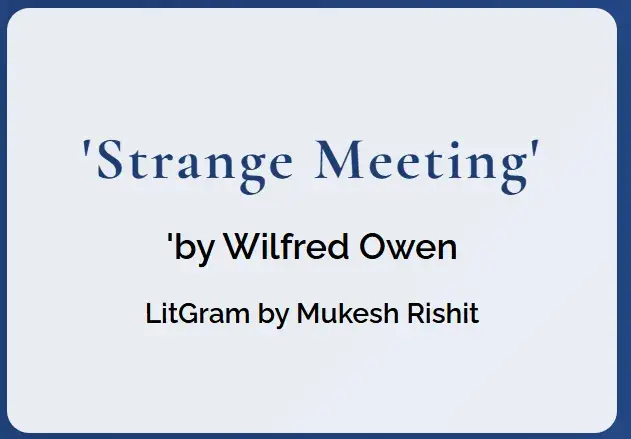Introduction
Wilfred Owen’s “Strange Meeting” is one of the most powerful anti-war poems ever written. Composed during World War I but published posthumously in 1920, this haunting poem depicts a soldier who escapes battle only to find himself in Hell, confronting an enemy soldier he killed the previous day. Through this supernatural encounter, Owen delivers a devastating critique of war’s futility and waste.
The poem’s unflinching portrayal of warfare’s psychological and physical devastation makes it essential reading for students of English literature, war poetry, and 20th-century writing. In this comprehensive “Strange Meeting” summary, we’ll explore Owen’s masterpiece through multiple lenses to reveal its enduring power and relevance.
Historical Context of “Strange Meeting”
World War I and the Poet-Soldiers
Wilfred Owen wrote “Strange Meeting” in 1918, during the final year of World War I. This global conflict, known then as the “Great War,” claimed over 9 million soldiers’ lives and left countless others physically and psychologically devastated.
Owen himself served as a lieutenant in the Manchester Regiment and experienced the horrors of trench warfare firsthand. This direct exposure to warfare’s brutality fundamentally shaped his poetry and provided the authentic details that make “Strange Meeting” so powerful.
The war produced a generation of poet-soldiers including Owen, Siegfried Sassoon, Isaac Rosenberg, and Robert Graves, whose work challenged romanticized notions of combat with unflinching portrayals of its reality.
Owen’s Military Experience and Death
Owen’s personal journey through the war adds poignancy to “Strange Meeting”:
- Enlisted in 1915 and sent to the Western Front in 1917
- Experienced shell shock (now recognized as PTSD) and was sent to Craiglockhart War Hospital
- Met fellow poet Siegfried Sassoon, who encouraged his writing
- Returned to combat despite having the option to remain in England
- Killed in action on November 4, 1918, just one week before the Armistice
The poem’s exploration of death, missed potential, and the brotherhood between enemies takes on additional significance knowing Owen himself would not survive the conflict he wrote about.
Structure and Style Analysis
Formal Elements and Techniques
“Strange Meeting” consists of 44 lines of loose iambic pentameter. While the poem appears structured at first glance, Owen deliberately subverts traditional poetic forms to mirror the chaos of war:
- Irregular stanza breaks
- Half-rhymes rather than perfect rhymes (wound/land, groaned/mind)
- Varying line lengths
- Internal rhymes and alliteration
These technical choices create an unsettled feeling for the reader, subtly reinforcing the disorientation experienced by the poem’s speaker.
Owen’s Distinctive Voice
Several hallmarks of Owen’s mature poetic style appear in “Strange Meeting”:
- Direct, conversational language punctuated by stunning imagery
- Paradoxical phrasing (“the pity of war, the pity war distilled”)
- Sensory details that evoke battlefield conditions
- Pararhymes (imperfect rhymes) that suggest discord
- Biblical and classical allusions woven into modern warfare
The poem demonstrates why Owen is considered the definitive poetic voice of World War I—he combines technical virtuosity with unforgettable emotional impact.
Line-by-Line Analysis of Key Passages
The Opening Descent
The poem begins with a soldier’s escape from battle:
“It seemed that out of battle I escaped
Down some profound dull tunnel, long since scooped
Through granites which titanic wars had groined.”
This opening establishes several important elements:
- The speaker’s uncertain mental state (“It seemed”)
- Movement from the battlefield to an underworld
- Reference to “titanic wars”—suggesting both mythological conflicts and the ongoing world war
- The image of a tunnel carved through hard granite—implying both physical trenches and a metaphorical passage to the afterlife
The “escape” initially seems positive but quickly reveals itself as a descent into Hell.
The Encounter with the Dead Soldier
The central meeting occurs when the speaker encounters another soldier:
“Then, as I probed them, one sprang up, and stared
With piteous recognition in fixed eyes,
Lifting distressful hands, as if to bless.
And by his smile, I knew that sullen hall,—
By his dead smile I knew we stood in Hell.”
This passage reveals:
- The shock of recognition between the two men
- The paradoxical “dead smile” that confirms their location in Hell
- The Christ-like gesture of blessing from the dead soldier
- The speaker’s dawning realization of his own death
The moment transforms from potential threat to a strange communion between former enemies.
Themes and Symbolism
The Futility of War
The central message of “Strange Meeting” is the senselessness of warfare and its waste of human potential. The dead soldier explicitly states:
“None will break ranks, though nations trek from progress…
The pity of war, the pity war distilled”
This condemnation emphasizes:
- The endless cycle of warfare throughout human history
- How nationalism overrides individual conscience
- War’s destruction of cultural and intellectual progress
- The concentration of human suffering (“distilled”)
Rather than glorifying battlefield heroism, Owen portrays war as a crushing force that destroys both victor and vanquished.
Identity and Brotherhood
The poem explores the bizarre kinship between enemies who share the experience of warfare:
- The soldiers recognize each other across enemy lines
- They share the same fate despite fighting for opposing sides
- Their conversation reveals shared values and humanity
- The dead soldier calls the speaker “my friend”
This theme emphasizes how arbitrary national divisions seem in the face of death—both men are ultimately victims of the same conflict.
Lost Potential and Truncated Lives
The German soldier speaks poignantly about what might have been:
“I would have poured my spirit without stint
But not through wounds; not on the cess of war.
Foreheads of men have bled where no wounds were.”
This passage emphasizes:
- Creative potential destroyed by war
- The contrast between physical and intellectual/emotional wounds
- The speaker’s desire to create rather than destroy
- The metaphorical “bleeding” of thought and imagination
The poem suggests war’s greatest tragedy may be the lost potential of a generation—poems unwritten, discoveries unmade, lives unlived.
Literary Influences and Connections
Dante’s “Inferno”
“Strange Meeting” draws significantly from Dante’s “Inferno,” particularly:
- The descent into an underworld
- Encounters with the dead
- Conversations that reveal moral truths
- The structured nature of Hell
Owen transforms these classical elements into a modern context, creating a 20th-century Hell shaped by industrialized warfare.
Biblical Parallels
The poem contains several biblical allusions:
- The journey to an underworld echoes Christ’s harrowing of Hell
- The gesture of blessing from the dead soldier resembles Christ’s forgiveness
- References to “blood” and “veil” suggest biblical sacrifice
- The concept of reconciliation between enemies reflects Christian teaching
These religious elements give the poem a spiritual dimension beyond its anti-war message.
Connections to Other War Poets
“Strange Meeting” shares themes with other notable WWI poetry:
| Poet | Work | Shared Themes |
|---|---|---|
| Siegfried Sassoon | “Counter-Attack” | Graphic depictions of violence, anti-war sentiment |
| Isaac Rosenberg | “Break of Day in the Trenches” | Ironic tone, fraternization with the enemy |
| Rupert Brooke | “The Soldier” | Death in foreign soil (though with contrasting sentiment) |
| Ivor Gurney | “To His Love” | Preservation of the dead soldier’s memory |
Owen’s work is generally considered the most technically accomplished of the war poets, combining raw emotional impact with sophisticated poetic technique.
Impact and Critical Reception
Contemporary and Early Reception
“Strange Meeting” was published posthumously in 1920, after Owen’s death in combat. Its initial reception was mixed:
- Some critics praised its technical innovation and emotional power
- Others found its anti-war message unpatriotic
- Established poets like Yeats initially excluded Owen from anthologies
- Fellow soldiers recognized its authentic portrayal of combat experience
As the full horror of the war became apparent, the poem gained wider appreciation.
Modern Critical Assessment
Today, “Strange Meeting” is recognized as one of the greatest war poems in English literature:
- Regularly included in poetry anthologies and literature curricula
- Praised for its technical innovation, particularly the use of pararhyme
- Valued for its psychological complexity and moral depth
- Considered Owen’s most accomplished work alongside “Dulce et Decorum Est”
Critics particularly note the poem’s balance of personal experience and universal themes, making it both historically specific and timeless.
Key Takeaways
- “Strange Meeting” represents the pinnacle of WWI poetry, combining technical innovation with profound anti-war sentiment
- The poem depicts a soldier’s encounter with an enemy he killed, highlighting the shared humanity of supposed enemies
- Owen uses pararhyme and other technical devices to create a sense of discord that mirrors warfare’s chaos
- The work draws on Dante’s “Inferno” and biblical imagery to elevate its message beyond a simple war narrative
- Owen’s own death in combat adds poignancy to the poem’s exploration of wasted potential
- The poem remains relevant as a reminder of war’s psychological and human costs
The Modern Relevance of “Strange Meeting”
In Literature and Education
Owen’s poem continues to influence contemporary literature and education:
- Regularly taught in schools and universities worldwide
- Referenced in modern war literature and film
- Used in peace studies and conflict resolution curricula
- Studied alongside contemporary war poetry from other conflicts
Its technical innovations continue to influence poets today, while its themes remain tragically relevant.
In Contemporary Conflicts
The poem’s message resonates with modern warfare experiences:
- The psychological impact of combat (now recognized as PTSD)
- The artificial division between “enemy” combatants
- The waste of human potential in ongoing conflicts
- Questions about nationalism and its costs
In an era of ongoing global conflicts, the poem’s central message about war’s futility remains as powerful as ever.
Conclusion
Wilfred Owen’s “Strange Meeting” transcends its origins as a World War I poem to become a timeless meditation on warfare, humanity, and lost potential. Through its haunting descent into Hell, unexpected encounter between enemies, and powerful imagery, the poem delivers one of literature’s most devastating critiques of war. Owen’s technical innovations—particularly his use of pararhyme and sensory details—create a reading experience that mirrors the disorientation of combat and its aftermath.
For students of literature, “Strange Meeting” offers rich ground for exploration of poetic technique, historical context, and enduring human themes. As warfare continues to shape our world, Owen’s masterpiece remains not just a historical artifact but an urgent reminder of conflict’s true cost—measured not just in lives lost but in all that might have been.
FAQ About “Strange Meeting”
What is the main theme of “Strange Meeting”? The central theme is the futility of war and its waste of human potential. The poem also explores the artificial divisions between enemies, the psychological impact of combat, and the tragedy of unfulfilled creative potential.
Why is the poem called “Strange Meeting”? The title refers to the unusual encounter between the narrator and the enemy soldier he killed, now meeting in the afterlife. The “strangeness” comes from the unexpected reconciliation and recognition between former enemies.
Was “Strange Meeting” published during Owen’s lifetime? No, like most of Owen’s poetry, “Strange Meeting” was published posthumously. It appeared in his first collection in 1920, after he was killed in action on November 4, 1918—just one week before the Armistice ended World War I.
How does Owen use rhyme differently in this poem? Instead of traditional perfect rhymes, Owen uses pararhyme (or half-rhyme)—words that have the same consonants but different vowel sounds (groined/groaned, hair/hour). This creates a subtle discord that reinforces the poem’s unsettling themes.
What influence did Dante have on “Strange Meeting”? The poem draws heavily from Dante’s “Inferno,” particularly in its depiction of a descent into an underworld and conversations with the dead. Owen modernizes these classical elements by placing them in the context of World War I.
Are you studying war poetry for your English literature course? You might also be interested in our guide to Modernist Poetry of Eliot.


